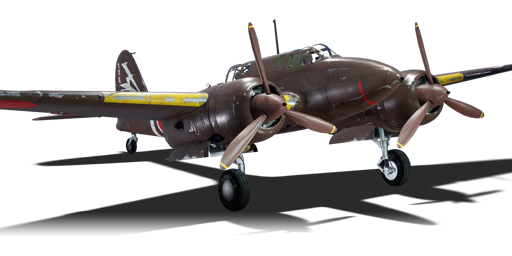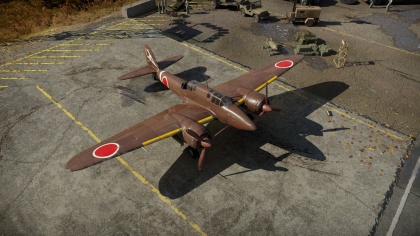Difference between revisions of "Ki-45 hei"
(Added tables and basic info.) |
(Updated information.) |
||
| Line 32: | Line 32: | ||
! RB | ! RB | ||
|- | |- | ||
| − | | | + | | 548 || 538 || {{Specs|ceiling}} || 25.1 || 25.5 || 17.0 || 17.0 || 520 |
|- | |- | ||
! colspan="8" | ''Upgraded'' | ! colspan="8" | ''Upgraded'' | ||
| Line 193: | Line 193: | ||
| Radiator | | Radiator | ||
| | | | ||
| + | | Turret 7 mm | ||
| | | | ||
|- | |- | ||
| Line 199: | Line 200: | ||
| Compressor | | Compressor | ||
| Airframe | | Airframe | ||
| + | | New 7 mm MGs (Turret) | ||
| | | | ||
|- | |- | ||
| Line 205: | Line 207: | ||
| Engine | | Engine | ||
| | | | ||
| + | | Offensive 20 mm | ||
| | | | ||
|- | |- | ||
| Line 211: | Line 214: | ||
| Engine Injection | | Engine Injection | ||
| Cover | | Cover | ||
| − | | | + | | New 20 mm Cannons |
| + | | New 37 mm Cannons | ||
|- | |- | ||
|} | |} | ||
Revision as of 01:40, 20 December 2018
Contents
| This page is about the aircraft Ki-45 hei. For other uses, see Ki-45 (Disambiguation) |
Description
The Ki-45 hei Toryu is a Rank Japanese twin-engine fighter
with a battle rating of (AB), (RB), and (SB). This aircraft was introduced in Update 1.31.
Being a classed as a heavy fighter, the Ki-45 isn't the best in the maneuverability category. However, for a heavy fighter, it maneuvers very well. It is even capable of out-turning aircraft such as the P-47D-25. Unlike heavy fighters of other nations, the Ki-45 series does not feature aircraft with large amounts of heavy weaponry. This is a major downside, considering how heavy fighters traditionally give up maneuverability and speed for armament. Instead, the Ki-45s utilize more of an equilibrium between maneuverability, speed, and armament. These are what makes the Ki-45 both a capable dog-fighter, and bomber hunter.
General info
Flight Performance
| Characteristics | |||||||
|---|---|---|---|---|---|---|---|
| Stock | |||||||
| Max Speed (km/h at 6,300 m) |
Max altitude (meters) |
Turn time (seconds) |
Rate of climb (meters/second) |
Take-off run (meters) | |||
| AB | RB | AB | RB | AB | RB | ||
| 548 | 538 | 25.1 | 25.5 | 17.0 | 17.0 | 520 | |
| Upgraded | |||||||
| Max Speed (km/h at 6,300 m) |
Max altitude (meters) | Turn time (seconds) | Rate of climb (meters/second) |
Take-off run (meters) | |||
| AB | RB | AB | RB | AB | RB | ||
| ? | ? | ??.? | ??.? | ??.? | ??.? | 520 | |
Details
| Features | ||||
|---|---|---|---|---|
| Combat flap | Take-off flap | Landing flap | Air brakes | Arrestor gear |
| ✓ | ✓ | ✓ | X | X |
| Limits | ||||
|---|---|---|---|---|
| Wing-break speed (km/h) |
Gear limit (km/h) |
Combat flap (km/h) |
Max Static G | |
| + | - | |||
| 390 | ~11 | ~7 | ||
| Optimal velocities | |||
|---|---|---|---|
| Ailerons (km/h) |
Rudder (km/h) |
Elevators (km/h) |
Radiator (km/h) |
| < 360 | < 320 | < 450 | > 280 |
| Compressor (RB/SB) | ||
|---|---|---|
| Setting 1 | ||
| Optimal altitude | 100% Engine power | WEP Engine power |
| 1,800 m | 2,080 hp | 2,271 hp |
| Setting 2 | ||
| Optimal altitude | 100% Engine power | WEP Engine power |
| 5,100 m | 1,870 hp | 2,042 hp |
Survivability and armour
- 16 mm Steel plates behind the pilot
Armaments
Offensive armament
The Ki-45 hei is armed with:
- 1 x 37 mm Ho-203 cannon, nose-mounted (15 rpg)
- 1 x 20 mm Ho-3 cannon, belly-mounted (100 rpg)
Defensive armament
The Ki-45 hei is defended by:
- 1 x 7.92 mm Type 98 machine gun, dorsal turret (1,050 rpg)
Usage in the battles
This variant of the Ki-45, the Ki-45 hei, features virtually the same armament as the Ki-45 otsu. Wielding one Ho-3 20 mm cannon and one Ho-203 37 mm cannon, the Ki-45 hei is the pinnacle of a multi-purpose aircraft. Its 37 mm cannon allows it to take down bombers with ease, and its single 20 mm cannon allows for some flexibility in the dog-fighting department. Although deadly, the 37 mm cannon only holds 15 rounds, so shot placement is crucial. The round itself also travels fairly slowly in the air, making it hard to hit fast moving enemy fighters. The 20 mm cannon is best used in an anti-fighter role. Unfortunately, the Ki-45's ground attack role is minimal due to the inability to equip armor piercing rounds for the 37 mm cannon. The Ki-45 hei is also unable to equip bombs.
The Ki-45 hei also retains its impressive turn rate from the Ki-45 tei. Although the aircraft itself is large and presents an "easy target" in many players' minds, the Ki-45 is rather nimble. Use this to your advantage when engaging enemy aircraft. Unfortunately, the Ki-45 is a heavy fighter, meaning its turn time is still not on par with other aircraft such as the F2A-3. In certain cases, the Ki-45 pilot may have to rely on his or her tail gunner to get the job done. The "otsu" version of the Ki-45 features a 7.92 mm Type 98 machine gun with 1050 rounds. Although lackluster, with shot placement it is possible to destroy enemies on the aircraft's tail. Aim for the pilot or the engine, as those are generally the weakest points on most aircraft. If the tailing enemy is a bi-plane, aim for the wings since they are very fragile.
The Toryu is also rather fragile for a heavy fighter. Although it does feature two engines, the Ki-45 does not have very much armor protection. Only the back of the pilot's seat has armor, leaving both the gunner and engines unprotected. This can prove costly in a fight. If one does find him or herself tailed, call upon teammates for assistance.
Tactics
The Ki-45 hei's armament is much more suited for bomber hunting than its earlier machine gun armed variant. With a moderate ammunition pool, it is easily possible to destroy multiple enemies with this aircraft. It is recommended to use the 20 mm cannon only when the pilot is sure he or she will hit the enemy aircraft, as it only holds 100 shells. The 37 mm cannon does impressive damage but requires a high degree of accuracy and lead. Practicing with this weapon will help greatly, especially when attacking fighters.
Manual Engine Control
| MEC elements | ||||||
|---|---|---|---|---|---|---|
| Mixer | Pitch | Radiator | Supercharger | Turbocharger | ||
| Oil | Water | Type | ||||
| Controllable | Not controllable | Not controllable | Not controllable | Separate | Not ontrollable | Not controllable |
Modules
| Tier | Flight performance | Survivability | Weaponry | ||
|---|---|---|---|---|---|
| I | Fuselage Repair | Radiator | Turret 7 mm | ||
| II | Compressor | Airframe | New 7 mm MGs (Turret) | ||
| III | Wings Repair | Engine | Offensive 20 mm | ||
| IV | Engine Injection | Cover | New 20 mm Cannons | New 37 mm Cannons | |
- Instead of focusing on armament like other heavy fighters, the Ki-45 is more balanced between armament and flight performance.
- While the default ammunition belts for both weapons on the Ki-45 ko are workable, it can help to upgrade.
- Unlocking the flight performance modules will help drastically in dogfights and turn fights.
Pros and cons
Pros:
- Highly powerful 37 mm cannon
- Good maneuverability and climb rate for a heavy fighter
- Acceptable top speed
- 16.5mm of armor in pilot's seat and added armor in nose around 37 mm gun
- Two engine design
Cons:
- Beat in turn fights by some aircraft
- Prone to fuel and engine fires
- Locks up at high speeds
- Mediocre roll rate, gets worse as speed increases
- Limited ammunition for all weapons
- Lack of protection around fuel tanks, engines, and gunner
- Long cannon reload time (no armor)
- Pilot is exposed in head-ons
- Limited anti-fighter capabilities
History
Initially designed to be a bomber escort, the Ki-45 was first deployed in what is now China and Vietnam. It was found to be easily outclassed by P-40s piloted by the Flying Tigers. As a result, the Ki-45's role was changed to anti-shipping and ground attack, where it performed satisfactorily. Nonetheless, the Ki-45's greatest strength proved to be its bomber intercepting capabilities. Heavily armed with 37 mm cannon, the Toryu (Dragon Slayer) could destroy heavy bombers with ease. As the war progressed, the need for an interceptor to defend the Japanese mainland was ever present. Soon, the Ki-45 was deployed to counter B-29 Superfortress raids. Although its armament was clearly deadly enough, the Ki-45 suffered at high altitudes. Pilots soon resorted to ramming attacks against the Superfortresses. Special attack groups specifically designed for this purpose formed, but by late 1945 Imperial Japan's fate had been sealed. The Allies allocated the name "Nick" to the Ki-45.
Media
An excellent addition to the article will be video guides, as well as screenshots from the game and photos.
Read also
Links to the articles on the War Thunder Wiki that you think will be useful for the reader, for example,
- reference to the series of the aircraft;
- links to approximate analogues of other nations and research trees.
Sources
Paste links to sources and external resources, such as:
- topic on the official game forum;
- page on aircraft encyclopedia;
- other literature.
| Japan twin-engine fighters and strike aircraft | |
|---|---|
| Navy | |
| Land-based Fighter | |
| J1N | J1N1 |
| J5N | J5N1 |
| Army | |
| Ki-45 | Ki-45 ko · Ki-45 otsu · Ki-45 hei · Ki-45 tei |
| Ki-83 | Ki-83 |
| Ki-96 | Ki-96 |
| Ki-102 | Ki-102 otsu |
| Ki-108 | Ki-108 Kai |
| Ki-109 | Ki-109 |





